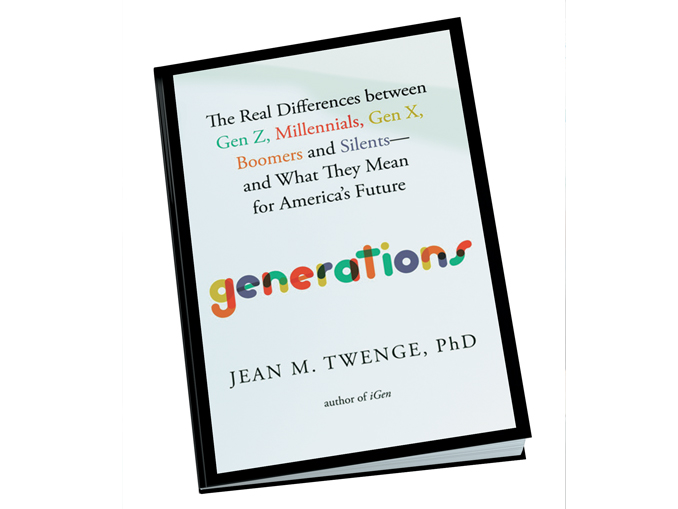 Reviewed by Cynthia Tello, Principal and Multicultural Insights Strategist, Smarketing Consulting and Research, LLC, San Antonio, Texas, cynthia.tello@smarketingcr.com
Reviewed by Cynthia Tello, Principal and Multicultural Insights Strategist, Smarketing Consulting and Research, LLC, San Antonio, Texas, cynthia.tello@smarketingcr.com
“As a primary instigator of generational and cultural change, technology presents the ultimate trade off. This is a challenge for all six generations in the decades to come: to find a way for technology to bring us together instead of driving us apart.”
Whether you are well versed in generational work or not, Generations will transform your viewpoint on the different cohorts in America and the catalysts behind cultural change.
Jean Twenge, a professor of psychology at San Diego State University, is an accomplished researcher and author of several books on generational change. In this fascinating book, Twenge overturns the conventional theory that generational differences are caused by major events and instead proposes a Technology Model of Generations. This model identifies Technology and its byproducts, Individualism and a Slower Life Trajectory, as the main trends shaping each generation, with technology being the root cause behind cultural change and generational differences.
In Generations, Twenge takes us on a captivating cultural journey through the last 100 years of American society, spanning six living generations in the U.S., from the Silent Generation (born 1925–1945) to Polars (born after 2012).
Twenge describes how America shifted from a collectivist society with rigid freedoms, customs, and roles, placing high value on the greater good, to a highly individualistic society today. It also depicts how social norms changed from the fast-life ideals of teen independence and people marrying in their early 20s to the slow-life trajectory with a longer childhood and deferred adult responsibilities.
Twenge’s thesis is that technology is at the base of all the radical transformations of the different generations, reshaping every aspect of our lives. Technology has relieved us from labor-intensive tasks, making our lives more convenient and freeing up time for individuals to focus on themselves, their needs, and their desires, thus paving the way for individualism.
Each generation has experienced individualism in unique ways. While Silents fought for the abolition of racial segregation and gender discrimination, Boomers experienced it initially as individual choice and self-expression, and later as self-fulfillment and spirituality. Gen X lived individualism as self-confidence and distrust of institutions; Millennials boosted positive self-views to new levels and supported LGBTQ people’s rights, whereas Gen Z exercises individualism through gender identity and cancel culture.
Twenge also describes how technology has led to “slower life trajectories.” As life expectancy increases and jobs become more knowledge-based, there is a greater need for higher education to succeed in a more competitive society. With parenting becoming more demanding, people are having fewer children and are nurturing them more extensively; hence, they take a longer time to reach the milestones of adolescence, adulthood, and old age.
Twenge’s methodological approach is rigorous and creative. Her hypothesis and insightful conclusions are based on robust datasets comprising 39 million people, many of which have national representation. Twenge dissects the generations from multiple perspectives, covering income, politics, education, gender, race, sexuality, marriage, religion, drug usage, and mental health.
Furthermore, she examines more ingenious and revealing elements, such as words that gained or lost relevance in books and the internet throughout the years, which cleverly illustrates the cultural shift toward individualism.
Toward the end of the book, Twenge addresses the implications and trade-offs that technology, individualism, and a slower-life trajectory have brought for Millennials, Gen Z, and Polars, and makes future predictions for American society. The picture is distressing.
Millennials, Gen Zers, and Polars have experienced the fastest adoption of any technology in human history, which correlates with large and sudden changes in mental health and behavior. As technology, individualism, and social media advance, so do depression, misinformation, political polarization, and feelings of disconnection and pessimism among younger generations. Hence, Twenge makes a call to “find a way for technology to bring us together instead of driving us apart.”
Reading this book is highly relevant at a time when change is happening at lightning speed. It provides a framework to link technological change, such as we are currently seeing with artificial intelligence, with cultural and generational trends. Demystifying generational differences and understanding how generations interplay as they navigate cultural change can increase empathy, reduce intergenerational conflict, and promote a harmonious, united front to solve the big challenges ahead of us.




